 W
WThe TVR Tasmin is a sports car designed by TVR and built in the United Kingdom by that company from 1980 to 1987. It was the first of TVR's "Wedge"-series which formed the basis of its 1980's model range. The Tasmin/280i was available as a 2-seater coupé, as a 2+2 coupé and as a 2-seater convertible.
 W
WIn 1982 TVR's then new owner Peter Wheeler found himself wanting more power than the Cologne V6-equipped Tasmin 280i could offer. Thus, based on the existing car the Tasmin 350i appeared in August 1983. Using the same chassis and body, a 3.5-litre Rover V8 was installed. After a year, the "Tasmin" part of the name was dropped and the car became plain TVR 350i.
 W
WThe TVR 350SE was a sports car designed and built by TVR starting in 1990 and ending in 1991. In 1990 TVR Engineering Limited produced a limited production run of 25 specially prepared 350's to mark the end of the era heralded by the 350i. This commemorated the previous 7 years of production during which time over a thousand 350i-model TVRs were manufactured. The limited production 350SE was seen as the ultimate progression of the 350i in terms of both outright performance and enjoyment.
 W
WIn 1982 TVR's then new owner Peter Wheeler found himself wanting more power than the Cologne V6-equipped Tasmin 280i could offer. Thus, based on the existing car the Tasmin 350i appeared in August 1983. Using the same chassis and body, a 3.5-litre Rover V8 was installed. After a year, the "Tasmin" part of the name was dropped and the car became plain TVR 350i.
 W
WThe TVR 390SE is a sports car designed and built by TVR. It was introduced in October 1984. It featured many novelties not found in other 'Wedge' TVRs before and was also the most powerful one yet. It never received British Type Approval, so technically speaking the 390SE was just a 350i with special equipment fitted.
 W
WThe TVR 400/450SE was a series of open sports cars designed and built by TVR in the late eighties and early nineties. The 400SE was introduced in 1988, the 450SE a year later. The 400SE was the last of the Wedges built, with the last cars being produced in late 1991 and registered in 1992. There were also special versions built, with two Sprintex supercharged 400SX built by dealer 'Northern TVR Centre' in 1989, and three Griffith engined 430SEs were constructed in 1991.
 W
WThe TVR 400/450SE was a series of open sports cars designed and built by TVR in the late eighties and early nineties. The 400SE was introduced in 1988, the 450SE a year later. The 400SE was the last of the Wedges built, with the last cars being produced in late 1991 and registered in 1992. There were also special versions built, with two Sprintex supercharged 400SX built by dealer 'Northern TVR Centre' in 1989, and three Griffith engined 430SEs were constructed in 1991.
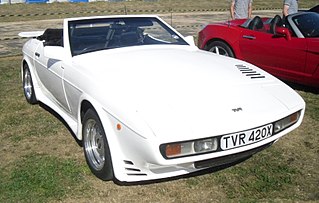 W
WThe TVR 420 SEAC is a sports car designed and built by TVR between 1986 and 1988. It is considered as the ultimate "wedge" TVR and is the final of TVR wedge family. Unlike the other wedges the 420 SEAC was different. The acronym SEAC stands for Special Equipment Aramid Composite, that means that more than 20% of the body was kevlar unlike the others wedges full fibreglass construction. The use of kevlar made the car more than 100 kg (220 lb) lighter without compromising the body rigidity. That, in addition to the highly tuned Rover V8 engine made the car extremely quick but had its effect on price which was twice as much as a standard 350i. In addition the SEAC models can be distinguished by the large rear spoiler and the rounder nose. By 1988 when the 420 SEAC was replaced by the even more powerful 450 SEAC about 40 cars had been built.
 W
WThe TVR 390SE is a sports car designed and built by TVR. It was introduced in October 1984. It featured many novelties not found in other 'Wedge' TVRs before and was also the most powerful one yet. It never received British Type Approval, so technically speaking the 390SE was just a 350i with special equipment fitted.
 W
WThe TVR 450 SEAC is a sports car designed and built by TVR in a one-year only run. It used the same fibreglass and kevlar body as the 420 SEAC and the same chassis. The only difference was the engine which grew to 4,5 litres and about 325 bhp (242 kW) and 435 Nm torque. As a consequence though the 450 SEAC was even more expensive to build and buy than the already expensive 420 SEAC, so about 17 were made. Curiously, rumour has it that more SEAC's are on the road now than were manufactured in the first place, that is because many wedges were converted to 450 SEAC spec afterwards.
 W
WThe TVR 400/450SE was a series of open sports cars designed and built by TVR in the late eighties and early nineties. The 400SE was introduced in 1988, the 450SE a year later. The 400SE was the last of the Wedges built, with the last cars being produced in late 1991 and registered in 1992. There were also special versions built, with two Sprintex supercharged 400SX built by dealer 'Northern TVR Centre' in 1989, and three Griffith engined 430SEs were constructed in 1991.
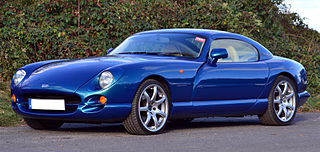 W
WThe TVR Cerbera is a grand touring sports car manufactured by British automobile manufacturer TVR between 1996 and 2006. The name is derived from Cerberus, the three-headed beast of Greek legend that guarded the entrance of Hades.
 W
WThe TVR Cerbera Speed 12, originally known as the Project 7/12, is a high performance sports car designed by TVR in 1997. Based on the TVR Cerbera, the vehicle was intended to be both the world's highest performance road car and the basis for a GT1 class endurance racer. However, problems during its development, changing GT1 class regulations and the eventual decision that it was simply incapable of being used as a road car forced TVR executives to abandon its development.
 W
WThe TVR Chimaera is a two-seater roadster sports car manufactured by TVR between 1992 and 2003. The name was derived from Chimera, the monstrous creature of Greek mythology, which was made of the parts of multiple animals.
 W
WThe TVR Grantura is the first production model in a long line of TVR cars. It debuted in 1958 and went through a series of developments leading to the Mark I to Mark IV and 1800S models. The last ones were made in September 1967.
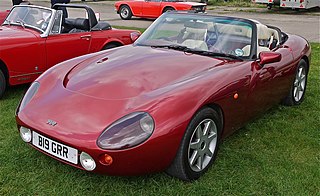 W
WThe TVR Griffith, later models being referred to as the Griffith 500, is a sports car designed and built by TVR, starting production in 1991, and ending production in 2002. The Griffith name appeared again on a sports car introduced under a revived TVR brand in 2017.
 W
WThe TVR Griffith 200 was a lightweight fibreglass-body sports car. In the United States, the make was Griffith and the model was Griffith Series 200, whilst the United Kingdom the make was TVR and the model was Griffith 200.
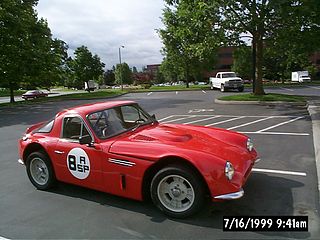 W
WThe TVR Griffith Series 400 is a 2-door coupe sports car produced by Griffith Motor Company in Plainview, New York, between 1964 and 1967. It was the successor to the TVR Griffith 200, featuring improved cooling via a larger radiator with twin electric fans, redesigned rear suspension, and a redesigned rear with better visibility and the round taillights sourced from the Ford Cortina Mark I.
 W
WThe TVR M series is a line of sports cars built by automaker TVR between 1972 and 1979. The series replaced the outgoing TVR Vixen and Tuscan models, and is characterized by a common chassis and shared body style. As with other TVR models before and since, the M-series cars use a front mid-engine, rear-wheel drive layout and body-on-frame construction. The bodies themselves were built from glass-reinforced plastic (GRP). The era of the M series is commonly associated with Martin Lilley who, together with his father, took ownership of the company on 30 November 1965.
 W
WThe TVR S series, a line of sports cars, was announced at the 1986 British International Motor Show. Due to a massive positive response, the car went into production in less than 12 months, with 250 pre-manufacture orders. This was Peter Wheeler's first major development since buying the company from Martin Lilley, and the turning point in TVR's fortunes.
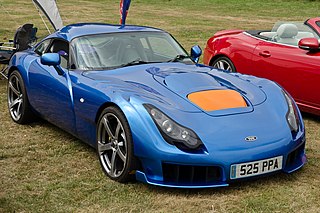 W
WThe TVR Sagaris is a sports car designed and built by the British manufacturer TVR in their factory in Blackpool, Lancashire.
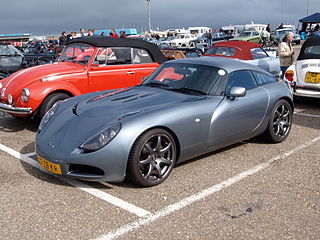 W
WThe TVR T350 is a sports car manufactured by British automobile manufacturer TVR from 2002 to 2006. It is based on the Tamora, and is powered by TVR's Speed Six engine displacing 3.6 litre form, rated at 350 hp (261 kW). The T350 was available in coupe and targa versions, the coupe version being known as the T350C, and the targa version the T350T. The T350 later formed the base of the Sagaris.
 W
WThe TVR Tamora is a 2-seater sports car built from 2002 by British automobile manufacturer TVR, filling the gap left by the company's Chimaera and Griffith models. Introduced at the 2000 Birmingham Motor Show, the car is named after Tamora, a character in William Shakespeare's play Titus Andronicus and served as an entry-level model in the TVR range. Peter Wheeler was no longer directly responsible for design and the car was designed by a team led by Damian McTaggart, but Wheeler still had final approval.
 W
WThe TVR Tasmin is a sports car designed by TVR and built in the United Kingdom by that company from 1980 to 1987. It was the first of TVR's "Wedge"-series which formed the basis of its 1980's model range. The Tasmin/280i was available as a 2-seater coupé, as a 2+2 coupé and as a 2-seater convertible.
 W
WThe TVR Tasmin is a sports car designed by TVR and built in the United Kingdom by that company from 1980 to 1987. It was the first of TVR's "Wedge"-series which formed the basis of its 1980's model range. The Tasmin/280i was available as a 2-seater coupé, as a 2+2 coupé and as a 2-seater convertible.
 W
WThe TVR Tuscan Speed Six is a sports car which was manufactured by British automobile manufacturer TVR from 1999 to 2006. The name pays homage to the original Tuscan which was introduced in 1967.
 W
WIn the late 1990s, the successful Tuscan Challenge race series was in need of updating and Peter Wheeler began the project that would fulfill his ambition to see TVRs at Le Mans. Work began on a completely new racing car that would be built using modern composites, be more rigid than any previous TVR and be CAD designed to reach speeds in excess of 200 mph (322 km/h) and be stable. The car itself would be a steel tubular frame with full roll cage forming the backbone to a full carbon fibre monocoque.
 W
WThe TVR Typhon is a sports car produced by the British car manufacturer TVR in their factory in Blackpool between 2000 and 2006. It is the fastest production TVR ever built. Only three were ever built. All are currently in England.
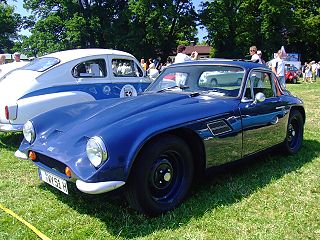 W
WThe TVR Vixen is a hand-built sports car which was produced by TVR and in Blackpool, England from 1967 until 1973. Ford-engined in most of its configurations, it succeeded the MGB-engined TVR Grantura 1800S. It is also the basis for the high-performance TVR Tuscan which was available in both V6 and V8 configurations.
 W
WThe TVR Wedges are a series of wedge-shaped sports cars built by British specialist sports car manufacturer TVR between 1980 and 1991. There were 2-seat convertibles and 2-seater or 2+2 liftback coupés, with four-, six- and eight-cylinder engines from a variety of manufacturers. The name refers to their sharp-nosed angular shape, particular to the late seventies when they were designed.